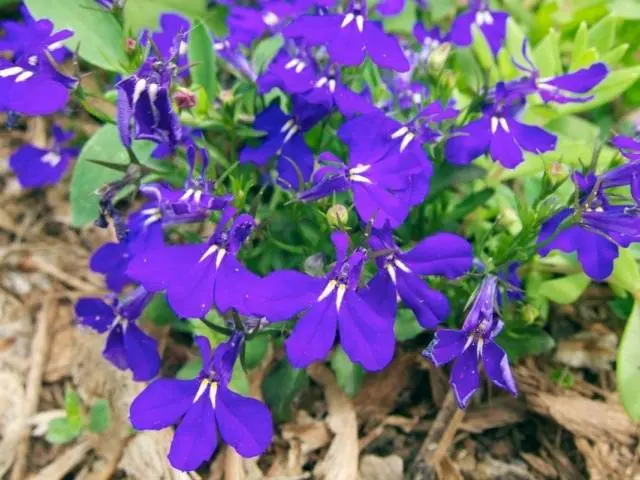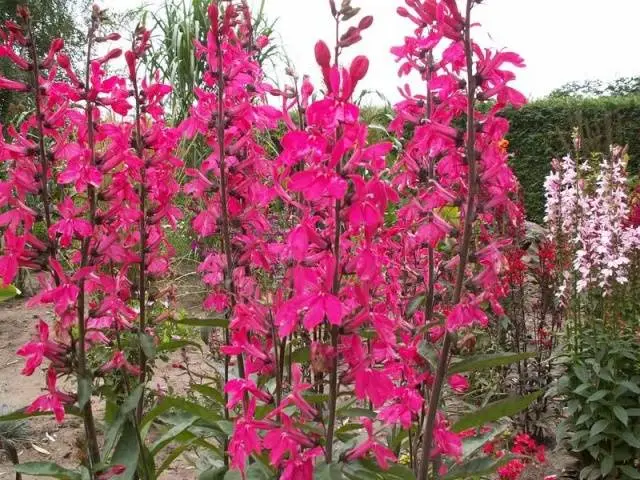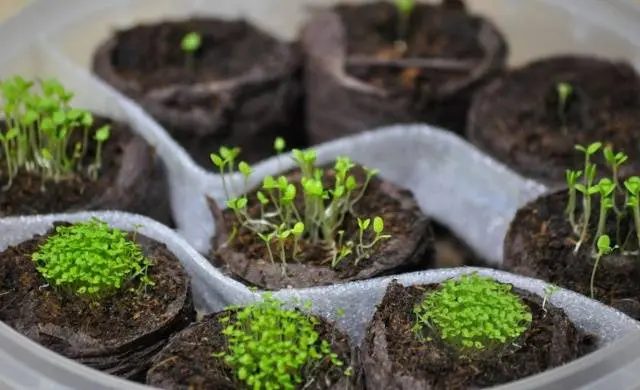Contents
Neat lobelia bushes in modern landscape design are found everywhere: they decorate flower beds, alpine slides, hanging planters and decorative flowerpots. This flower is versatile, besides it has a lot of delicate colors – from pink to purple and purple. Working with lobelia is a pleasure, but growing this plant in a temperate climate is quite difficult. The greatest difficulty lies in the reproduction of the flower, because it reproduces with the smallest seeds, similar to dust.
How to adapt a heat-loving flower to a temperate climate, how to grow lobelia from seeds and when it is better to plant seedlings in the ground – all the intricacies of the planting process at home will be discussed in the article. And here you can find recommendations on choosing a variety of lobelia and learn more about this plant.
Interesting facts about delicate flowers
Lobelia, according to most botanists, belongs to the Bellflower species (although some, nevertheless, classify it as a separate plant species – Lobelia). The homeland of this flower is the subtropics, but today it is distributed on almost all continents.

In nature, lobelia is a perennial, in colder climates it is grown as an annual plant. About three hundred species of this plant have medicinal properties and grow in nature. Lobelia is mainly treated for pulmonary diseases. This flower is actively used in pharmacology for the production of tablets and tinctures.

The description of the plant looks like this:
- perennial flower;
- has branching thin grassy stems;
- bushes spherical, compact;
- leaflets elongated, lanceolate, arranged in pairs;
- stems branch from the very roots;
- the height of the flower depends on its type (the dwarf variety grows only up to 20 cm, the shoots of erect varieties can grow up to 30 cm, but the climbing lobelia is grown as an ampelous plant and has a stem length of up to 50 cm);
- the length of the pedicels is only 2 cm;
- flowers bilabiate axillary, small;
- the colors of the flower can be any: white, blue, blue, purple, pink, lilac, red or multicolor;
- Lobelia blooms from June to September;
- the fruit of the flower is a box with numerous seeds.
Variety choice
In Our Country, lobelia is grown mainly as an annual plant. Therefore, it is better to choose a variety of this flower with an annual vegetation cycle. The most beautiful and spectacular landscape designers consider the following types:
Erinus

They call it blackberry, curb or, simply, blue. This type of lobelia can have several forms that differ in the size and shape of the bush (dwarf, compact, upright, climbing and sprawling). The most famous varieties of the Erinus species are Reggata Rose and Reggata Blue (blooming pink and blue, respectively), Riviera Sky Blue, which has sky blue flowers.
Lobelia Strong

Outwardly, it is very similar to Erinus, but its bushes are coarser. The stems are thicker, the leaves are larger and fleshier, the inflorescences have a larger diameter and can be colored blue or purple, there is always a white spot inside the flower.
Ricardi Ampelnaya

It is a hybrid, so it can only propagate by cuttings. The whips of this variety of lobelia are more spreading and powerful than those of Erinus, grow up to 35 cm in length. Inflorescences can have a diameter of up to two centimeters, flowers are painted in lilac or white.
Lobelia Fiery or Brilliant

It is considered erect, its shoots stretch up to 75 cm. Depending on the variety, the leaves of the flower can turn green or red. The best representative of the species is the Queen Victoria variety with large scarlet flowers and stems up to one and a half meters long.
Gerards

It is unique in that it can withstand frost down to -29 degrees, therefore it is grown as a perennial even in the coldest regions of the country. The height of the bushes is about 120 cm, the inflorescences are collected in large spikelets, the color is in purple tones. The most popular variety is Lobelia Vedrariensis.
There are dozens of species and hundreds of varieties of lobelia – every grower will be able to find something most suitable for himself. Before choosing a variety of flowers, you should decide on a landing site. After all, the bushes of these flowers differ quite strongly, therefore, for flowerpots and hanging planters, for example, completely different types are suitable.
How to get a unique flower in your garden
Lobelia is a beautiful flower, but rather capricious. In order for its cultivation to be successful, and flowering to be plentiful, it is necessary to create the following conditions:
- loose soil, light and not too fertile (loams and sandstones are perfect);
- the site should be well lit by the sun and be warm;
- the flower loves moisture, so it needs to be provided with regular watering;
- top dressing with mineral complexes is necessary, but it must be strictly dosed;
- It is necessary to improve the tillering of lobelia by cutting adult bushes and pinching seedlings.

Proper planting with seeds and competent care is the key to lush flowering and beautiful flower beds.
Planting seedlings
Sowing lobelia seeds is complicated by the fact that they are very small. The sprouts of the flower will be the same miniature, so it is difficult to take care of them, dive and transplant them to a permanent place – all this requires the utmost care on the part of the grower.
To decide when to sow lobelia for seedlings, you need to decide whether the flowers will be additionally highlighted. If the house has special lamps, then you can start sowing seeds in January. When the grower intends to use only natural light, it is better to postpone the sowing of seeds until at least the last days of February. And then, in cloudy weather, it is better to put a lamp near the container with seedlings, as the flower stretches out very quickly and weakens from lack of light.

Flowers sown in March and grown under natural light will be stronger and healthier, form powerful, profusely flowering bushes, and will please with immunity to various diseases (including the “black leg”).
Sowing Rules
The laborious process of growing lobelia seedlings must begin with the preparation of seeds. Since the seeds of this flower are dusty, they should be mixed with dry sand – this will ensure uniformity of sowing.

The next actions of the grower:
- Soil preparation. It can be either a purchased soil for seedlings of flowers, or a self-prepared mixture of soddy soil, peat, humus and river sand in equal proportions. If the mixture has an increased acidity, it is necessary to add lime or dolomite flour, since lobelia prefers neutral soils.
- The soil is laid out in a plastic container and tamped a little. Now the earth needs to be watered and left overnight. A seedling container is preferably shallow, with drainage holes.
- Flower seeds mixed with sand are placed on a clean sheet of paper. The paper is folded into a corner and with its help the seeds are scattered over the entire surface of the soil, trying to distribute them evenly.
- You should not sprinkle flower seeds, you just need to moisten them by spraying them with a spray bottle. A little manganese or a fungicide should be added to the water for the initial watering of seedlings to prevent seed rotting.
- The container is covered with glass or film and cleaned in a warm place for seed germination.

How to care for seedlings
Every day, the glass or film from the container must be removed and wiped dry so that condensation does not accumulate. After a week and a half, when lobelia shoots appear, the lid is removed from the container. Now you can put a container with lobelia seedlings in a plastic bag and tie its top – a small greenhouse will come out.

Flowers are placed in a well-lit place, but not under the direct rays of the sun. The walls of the “greenhouse” are wiped every day, removing condensate. At this stage, the lobelia needs to be watered regularly, preventing the soil from drying out – the flower does not like drought very much.
It is better to water fragile flowers from below, pouring warm water directly into the pan. You can use a syringe or a teaspoon to water the lobelia, but when watering from above, mold often forms on the surface of the soil.

If the flower seeds were not planted in separate peat tablets, the seedlings will have to dive – divided into individual containers. This process is significantly complicated by the miniature size of the seedlings.
How to dive lobelia:
- Before picking, the soil in containers with seedlings must be thoroughly moistened.
- Now the fused flowers are carefully divided with a coffee spoon into small groups of several plants.
- Transfer a group of flowers to an individual container with loose soil.
- Lightly compact the soil around the stems and water the seedlings.
Landing in the ground
It is necessary to plant lobelia in a permanent place in early June, when the earth warms up well and there is no threat of frost. Just as during a dive, the plants are carried in groups of several seedlings. A plot for planting flowers is chosen sunny or partial shade. The land there should be loose and moderately nutritious, because lobelia does not like excessive fertilizer (in such conditions, the bushes will be lush, and flowering will be scarce). But the flower loves moisture, so the soil should hold it well.

The interval between lobelia bushes in group plantings should be 10-15 cm. The soil around the lobelia seedlings is tightly tamped and watered abundantly with settled water.
How to care for flowers
Care for lobelia should be regular – this flower is quite capricious and demanding. Care steps are as follows:
- regular watering, especially during the dry season. Lobelia does not tolerate drought very well, but excessive moisture can also lead to rotting of the stems. In strong heat, bushes are watered daily, and ampel varieties twice a day. If the weather is cool and cloudy, watering should be reduced.

- Fertilize flowers should be 2-3 times per season. For these purposes, mineral complexes are used; lobelia does not tolerate organics well.
- During the summer, flower bushes are formed by cutting off excess shoots. Experienced flower growers recommend cutting the bush to a five-centimeter height in the middle of summer – this stimulates a new wave of flowering.

- At the end of summer, you can collect lobelia seeds. To do this, the bush is carefully cut off and shaken over a sheet of paper. Then the seeds are dried and placed in a cool dark place.
- In autumn, the bushes are uprooted, doing the same with lobelia as with other annuals.
Conclusion
Photos of tender lobelia are beautiful. This flower is universal: it is suitable for framing flower beds, the first line of borders and borders, as an ampelous and potted plant. Having decided on the variety, you need to start growing seedlings, because lobelia reproduces only by seeds. This work is painstaking, requiring extreme caution from the grower, but the result is worth it!

Read more about planting lobelia flowers for seedlings in this video:











